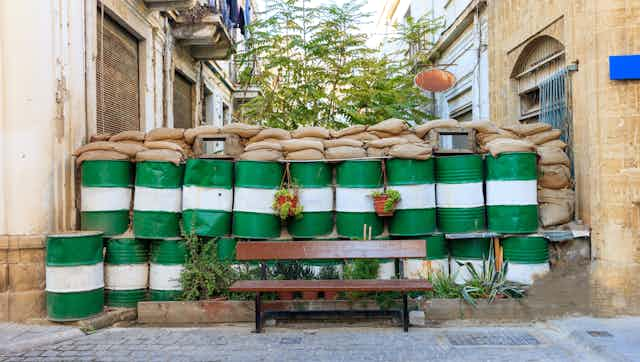Just over two decades ago, Sophia and Mehmet met at a North London party. She, originally from Deryneia in the southern part of Cyprus, had just arrived to study at Middlesex University. He, born in Gazimağusa in Northern Cyprus, had joined his uncle’s family in London a little earlier. They almost immediately fell in love with each other. Soon after I met them in June 1997, Sophia told me that falling in love with each other seemed an almost impossible feat. After all, a shared life back in Cyprus would have been fraught with challenges.
At the time, Sophia and Mehmet didn’t realise that back in Cyprus, the distance between the houses they grew up in was just over a mile – that they had on countless occasions watched the very same sunrise while looking for crabs at the same beach, divided only by a fence of barbed wire.
They grew up in two different worlds, where distances were not measured in the same way as elsewhere. Geographical proximity in Cyprus was negated by an impenetrable, frozen border. It had divided their island since 1974, when Turkey invaded in response to a Greece-backed military coup.
Until border crossing points were opened in 2003, Cypriots had few chances to meet people living on the other part of their island – and their awareness of what was happening there was largely shaped by state propaganda.
For Greek Cypriots, the official narrative focused on the Turkish invasion, with little mention of the campaign by the Greek paramilitary EOKA B – an organisation that divided the island for more than a decade before it was officially partitioned by military means. It forced Turkish Cypriots to flee and settle in enclaves in their very own homeland. It ripped communities apart.

As far as the Turkish side was concerned, the behaviour of EOKA B legitimised the formation of the paramilitary Turkish Resistance Organisation (TMT), and gave Turkey the opportunity to extend its control over the Turkish Cypriots. Many had sought refuge in the north, afraid of becoming second-class citizens in their own country or even being expelled – just as the Cretan Muslims had been a mere 50 years earlier.
The official Turkish Cypriot discourse encouraged by Turkish nationalists capitalised on and institutionalised that fear. It revolved around the systematic commemoration of atrocities by Greek Cypriot nationalists, emphasising the importance of Turkey as the “motherland” upon which Turkish Cypriots had called on for their salvation. And above all, it stifled any calls for coexistence.
In this environment of fear and suspicion, the memory of coexistence, with its positive and fraught moments alike, has faded over time. Older Cypriots passed away without the chance to return to the homes they fled or reconnect with old friends on the other side. Until 2003 “neutral” places outside Cyprus were the only places where Cypriots can meet each other, be exposed to each other’s partial truths and memories, fears and aspirations. They were the only places where they could form bonds of friendship and solidarity.
Hope springs
The protracted impasse has apparently worn out the segments of the electorate that previously supported reunification, and talk of full-on partition is no longer taboo in either side of the divide.
In the Turkish Cypriot parliamentary election of January 7 2018, the north’s nationalist right gathered strength; in the south, the rejectionist nationalists who derailed the Annan peace plan back in 2004, are gaining appeal in advance of the January 28 presidential vote.

But Cyprus is small – and its divided states are both weak and vulnerable. The 2013 banking crisis left deep wounds in the south, exposing its fragile development model> The north, meanwhile, is internationally isolated and heavily dependent on Turkey. Unification, it seems, could only benefit the island’s economy, not least by transforming the island’s natural resources from a political flashpoint into a shared source of wealth.
This is not the 1960s. Today, for all its faults, EU membership provides a safer environment in which Cypriots can consolidate peace and accommodate each other’s aspirations and fears. But that doesn’t mean it will be easy, and recent efforts underscore that there’s a long way to go.

In 2017, efforts to achieve a breakthrough were renewed. Greek and Turkish Cypriot leaders, the foreign ministers of the guarantor powers (Turkish, Greek and British), and the EU’s High Representative for Foreign Affairs and Security Policy tried to resuscitate the UN-sponsored talks on reunification – but while they reached a broad agreement, the devil was in the detail. In the end, the parties reverted to form, flexing their muscles and rehashing the same positions that had led to previous impasses.
With elections on both sides of the border this year, the future of the island is up in the air. But there’s still hope for a different Cyprus, one free of the symbolic and physical violence expressed in the language of “motherlands”. A Cyprus whose citizens, treated as adults, will not need barricades and buffer zones to feel safe; one where crossing streets, forming friendships and falling in love will not require permits from military authorities or approval by communal leaders.
To make this happen, a new Cyprus will have to develop institutions to address fears and mistrust, making armies and intervention clauses redundant. But in the end, once a modus vivendi of some sort is established, it will be up to Cypriots to make their island a common homeland once again.

